2001 CHRYSLER VOYAGER ESP
[x] Cancel search: ESPPage 3834 of 4284
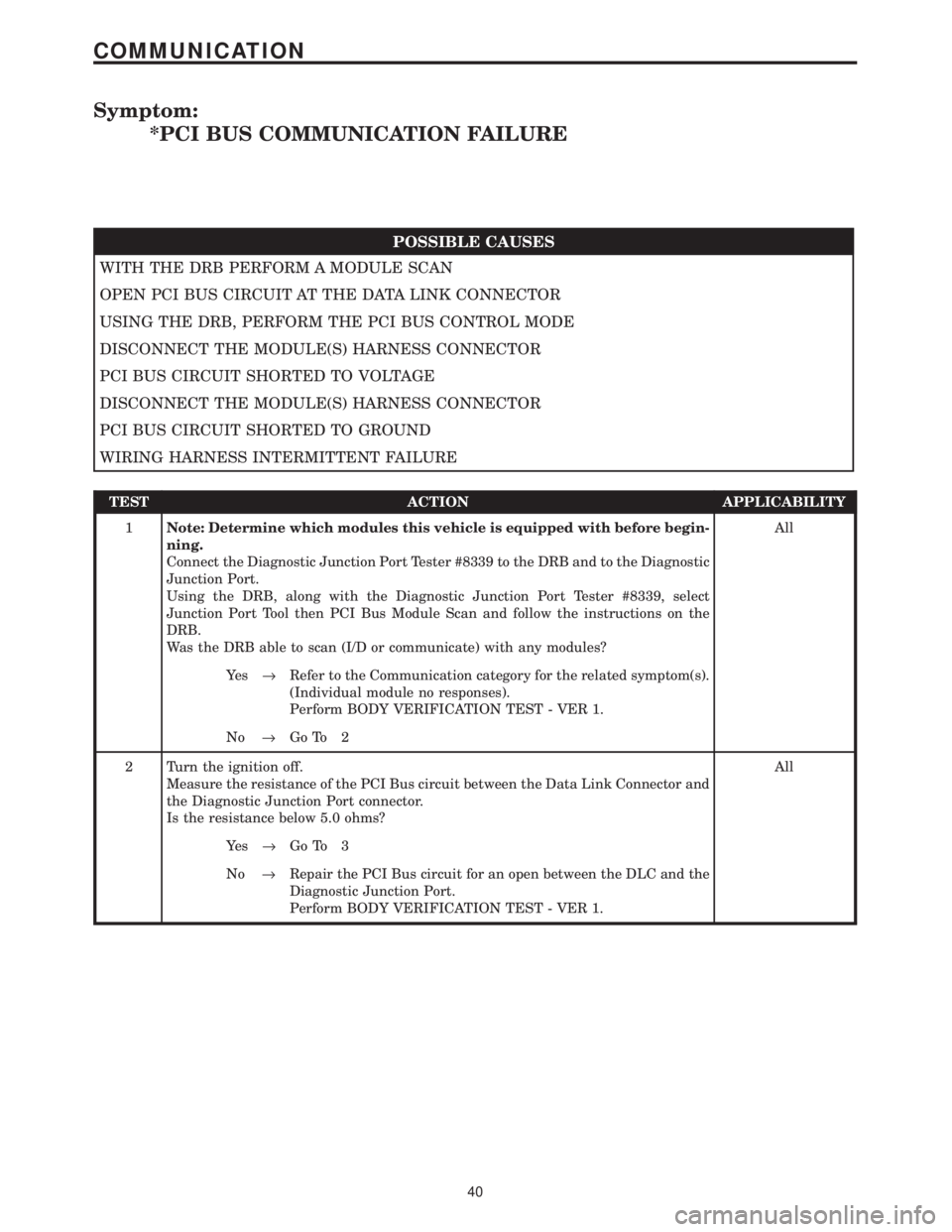
Symptom:
*PCI BUS COMMUNICATION FAILURE
POSSIBLE CAUSES
WITH THE DRB PERFORM A MODULE SCAN
OPEN PCI BUS CIRCUIT AT THE DATA LINK CONNECTOR
USING THE DRB, PERFORM THE PCI BUS CONTROL MODE
DISCONNECT THE MODULE(S) HARNESS CONNECTOR
PCI BUS CIRCUIT SHORTED TO VOLTAGE
DISCONNECT THE MODULE(S) HARNESS CONNECTOR
PCI BUS CIRCUIT SHORTED TO GROUND
WIRING HARNESS INTERMITTENT FAILURE
TEST ACTION APPLICABILITY
1Note: Determine which modules this vehicle is equipped with before begin-
ning.
Connect the Diagnostic Junction Port Tester #8339 to the DRB and to the Diagnostic
Junction Port.
Using the DRB, along with the Diagnostic Junction Port Tester #8339, select
Junction Port Tool then PCI Bus Module Scan and follow the instructions on the
DRB.
Was the DRB able to scan (I/D or communicate) with any modules?All
Ye s®Refer to the Communication category for the related symptom(s).
(Individual module no responses).
Perform BODY VERIFICATION TEST - VER 1.
No®Go To 2
2 Turn the ignition off.
Measure the resistance of the PCI Bus circuit between the Data Link Connector and
the Diagnostic Junction Port connector.
Is the resistance below 5.0 ohms?All
Ye s®Go To 3
No®Repair the PCI Bus circuit for an open between the DLC and the
Diagnostic Junction Port.
Perform BODY VERIFICATION TEST - VER 1.
40
COMMUNICATION
Page 3835 of 4284
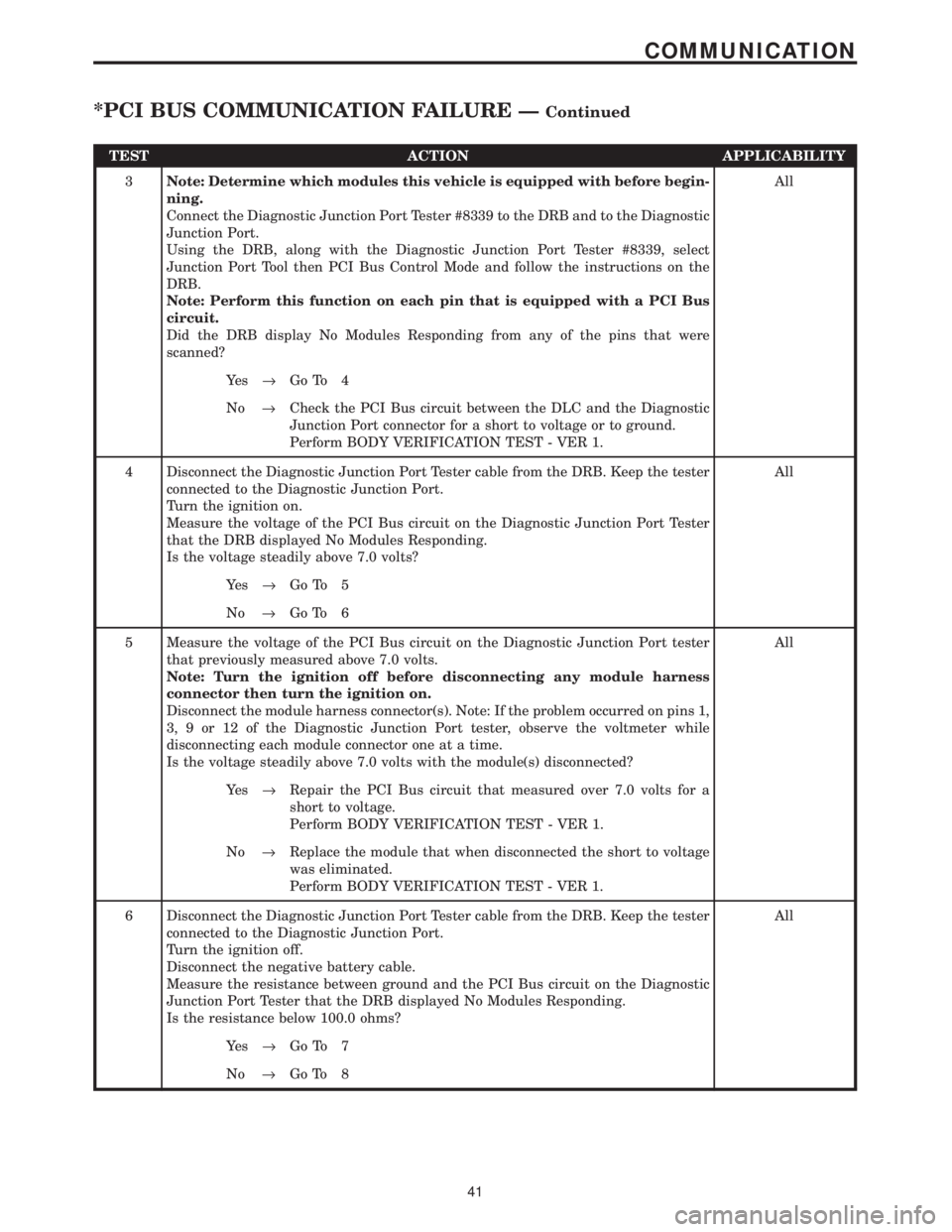
TEST ACTION APPLICABILITY
3Note: Determine which modules this vehicle is equipped with before begin-
ning.
Connect the Diagnostic Junction Port Tester #8339 to the DRB and to the Diagnostic
Junction Port.
Using the DRB, along with the Diagnostic Junction Port Tester #8339, select
Junction Port Tool then PCI Bus Control Mode and follow the instructions on the
DRB.
Note: Perform this function on each pin that is equipped with a PCI Bus
circuit.
Did the DRB display No Modules Responding from any of the pins that were
scanned?All
Ye s®Go To 4
No®Check the PCI Bus circuit between the DLC and the Diagnostic
Junction Port connector for a short to voltage or to ground.
Perform BODY VERIFICATION TEST - VER 1.
4 Disconnect the Diagnostic Junction Port Tester cable from the DRB. Keep the tester
connected to the Diagnostic Junction Port.
Turn the ignition on.
Measure the voltage of the PCI Bus circuit on the Diagnostic Junction Port Tester
that the DRB displayed No Modules Responding.
Is the voltage steadily above 7.0 volts?All
Ye s®Go To 5
No®Go To 6
5 Measure the voltage of the PCI Bus circuit on the Diagnostic Junction Port tester
that previously measured above 7.0 volts.
Note: Turn the ignition off before disconnecting any module harness
connector then turn the ignition on.
Disconnect the module harness connector(s). Note: If the problem occurred on pins 1,
3, 9 or 12 of the Diagnostic Junction Port tester, observe the voltmeter while
disconnecting each module connector one at a time.
Is the voltage steadily above 7.0 volts with the module(s) disconnected?All
Ye s®Repair the PCI Bus circuit that measured over 7.0 volts for a
short to voltage.
Perform BODY VERIFICATION TEST - VER 1.
No®Replace the module that when disconnected the short to voltage
was eliminated.
Perform BODY VERIFICATION TEST - VER 1.
6 Disconnect the Diagnostic Junction Port Tester cable from the DRB. Keep the tester
connected to the Diagnostic Junction Port.
Turn the ignition off.
Disconnect the negative battery cable.
Measure the resistance between ground and the PCI Bus circuit on the Diagnostic
Junction Port Tester that the DRB displayed No Modules Responding.
Is the resistance below 100.0 ohms?All
Ye s®Go To 7
No®Go To 8
41
COMMUNICATION
*PCI BUS COMMUNICATION FAILURE ÐContinued
Page 3853 of 4284
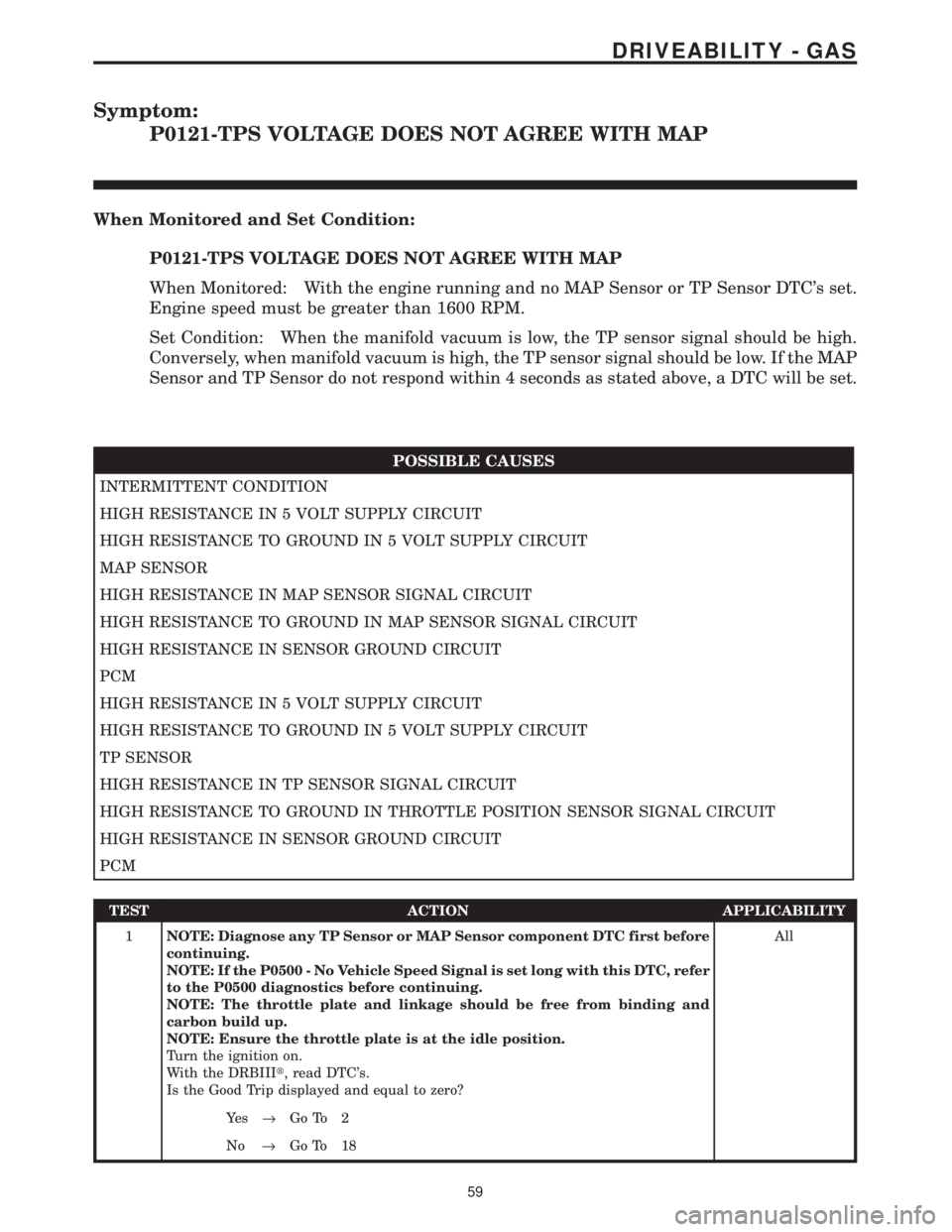
Symptom:
P0121-TPS VOLTAGE DOES NOT AGREE WITH MAP
When Monitored and Set Condition:
P0121-TPS VOLTAGE DOES NOT AGREE WITH MAP
When Monitored: With the engine running and no MAP Sensor or TP Sensor DTC's set.
Engine speed must be greater than 1600 RPM.
Set Condition: When the manifold vacuum is low, the TP sensor signal should be high.
Conversely, when manifold vacuum is high, the TP sensor signal should be low. If the MAP
Sensor and TP Sensor do not respond within 4 seconds as stated above, a DTC will be set.
POSSIBLE CAUSES
INTERMITTENT CONDITION
HIGH RESISTANCE IN 5 VOLT SUPPLY CIRCUIT
HIGH RESISTANCE TO GROUND IN 5 VOLT SUPPLY CIRCUIT
MAP SENSOR
HIGH RESISTANCE IN MAP SENSOR SIGNAL CIRCUIT
HIGH RESISTANCE TO GROUND IN MAP SENSOR SIGNAL CIRCUIT
HIGH RESISTANCE IN SENSOR GROUND CIRCUIT
PCM
HIGH RESISTANCE IN 5 VOLT SUPPLY CIRCUIT
HIGH RESISTANCE TO GROUND IN 5 VOLT SUPPLY CIRCUIT
TP SENSOR
HIGH RESISTANCE IN TP SENSOR SIGNAL CIRCUIT
HIGH RESISTANCE TO GROUND IN THROTTLE POSITION SENSOR SIGNAL CIRCUIT
HIGH RESISTANCE IN SENSOR GROUND CIRCUIT
PCM
TEST ACTION APPLICABILITY
1NOTE: Diagnose any TP Sensor or MAP Sensor component DTC first before
continuing.
NOTE: If the P0500 - No Vehicle Speed Signal is set long with this DTC, refer
to the P0500 diagnostics before continuing.
NOTE: The throttle plate and linkage should be free from binding and
carbon build up.
NOTE: Ensure the throttle plate is at the idle position.
Turn the ignition on.
With the DRBIIIt, read DTC's.
Is the Good Trip displayed and equal to zero?All
Ye s®Go To 2
No®Go To 18
59
DRIVEABILITY - GAS
Page 3873 of 4284
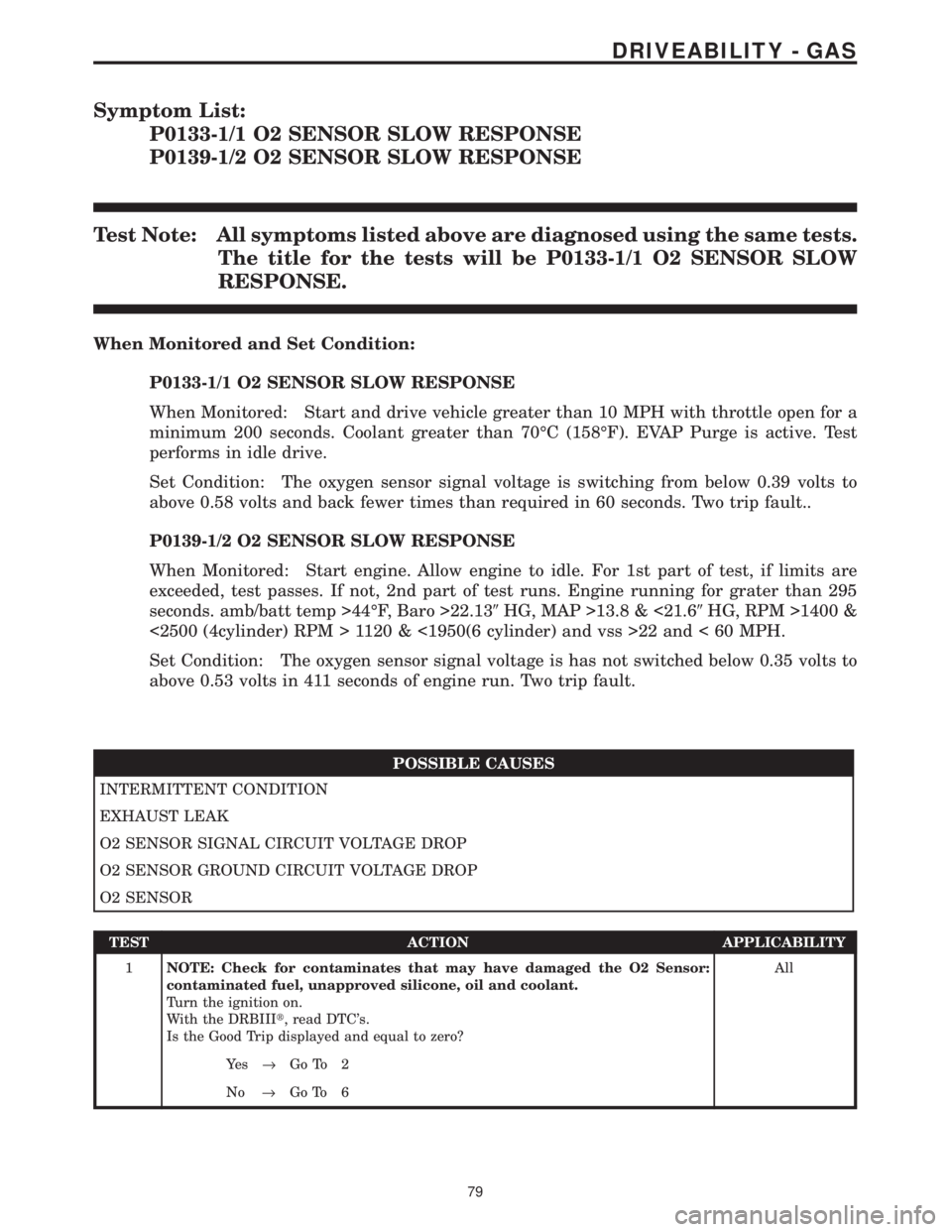
Symptom List:
P0133-1/1 O2 SENSOR SLOW RESPONSE
P0139-1/2 O2 SENSOR SLOW RESPONSE
Test Note: All symptoms listed above are diagnosed using the same tests.
The title for the tests will be P0133-1/1 O2 SENSOR SLOW
RESPONSE.
When Monitored and Set Condition:
P0133-1/1 O2 SENSOR SLOW RESPONSE
When Monitored: Start and drive vehicle greater than 10 MPH with throttle open for a
minimum 200 seconds. Coolant greater than 70ÉC (158ÉF). EVAP Purge is active. Test
performs in idle drive.
Set Condition: The oxygen sensor signal voltage is switching from below 0.39 volts to
above 0.58 volts and back fewer times than required in 60 seconds. Two trip fault..
P0139-1/2 O2 SENSOR SLOW RESPONSE
When Monitored: Start engine. Allow engine to idle. For 1st part of test, if limits are
exceeded, test passes. If not, 2nd part of test runs. Engine running for grater than 295
seconds. amb/batt temp >44ÉF, Baro >22.139HG, MAP >13.8 & <21.69HG, RPM >1400 &
<2500 (4cylinder) RPM > 1120 & <1950(6 cylinder) and vss >22 and < 60 MPH.
Set Condition: The oxygen sensor signal voltage is has not switched below 0.35 volts to
above 0.53 volts in 411 seconds of engine run. Two trip fault.
POSSIBLE CAUSES
INTERMITTENT CONDITION
EXHAUST LEAK
O2 SENSOR SIGNAL CIRCUIT VOLTAGE DROP
O2 SENSOR GROUND CIRCUIT VOLTAGE DROP
O2 SENSOR
TEST ACTION APPLICABILITY
1NOTE: Check for contaminates that may have damaged the O2 Sensor:
contaminated fuel, unapproved silicone, oil and coolant.
Turn the ignition on.
With the DRBIIIt, read DTC's.
Is the Good Trip displayed and equal to zero?All
Ye s®Go To 2
No®Go To 6
79
DRIVEABILITY - GAS
Page 3874 of 4284
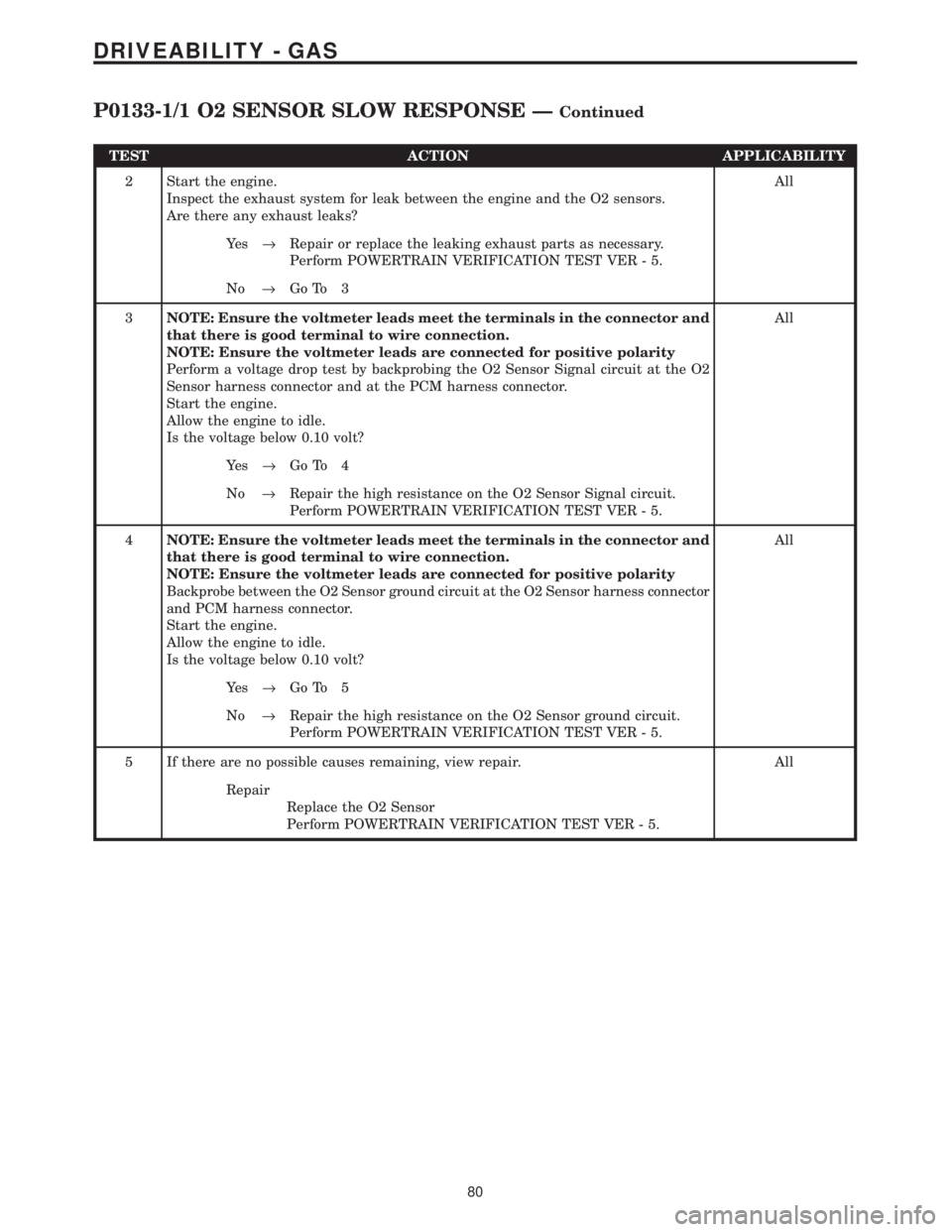
TEST ACTION APPLICABILITY
2 Start the engine.
Inspect the exhaust system for leak between the engine and the O2 sensors.
Are there any exhaust leaks?All
Ye s®Repair or replace the leaking exhaust parts as necessary.
Perform POWERTRAIN VERIFICATION TEST VER - 5.
No®Go To 3
3NOTE: Ensure the voltmeter leads meet the terminals in the connector and
that there is good terminal to wire connection.
NOTE: Ensure the voltmeter leads are connected for positive polarity
Perform a voltage drop test by backprobing the O2 Sensor Signal circuit at the O2
Sensor harness connector and at the PCM harness connector.
Start the engine.
Allow the engine to idle.
Is the voltage below 0.10 volt?All
Ye s®Go To 4
No®Repair the high resistance on the O2 Sensor Signal circuit.
Perform POWERTRAIN VERIFICATION TEST VER - 5.
4NOTE: Ensure the voltmeter leads meet the terminals in the connector and
that there is good terminal to wire connection.
NOTE: Ensure the voltmeter leads are connected for positive polarity
Backprobe between the O2 Sensor ground circuit at the O2 Sensor harness connector
and PCM harness connector.
Start the engine.
Allow the engine to idle.
Is the voltage below 0.10 volt?All
Ye s®Go To 5
No®Repair the high resistance on the O2 Sensor ground circuit.
Perform POWERTRAIN VERIFICATION TEST VER - 5.
5 If there are no possible causes remaining, view repair. All
Repair
Replace the O2 Sensor
Perform POWERTRAIN VERIFICATION TEST VER - 5.
80
DRIVEABILITY - GAS
P0133-1/1 O2 SENSOR SLOW RESPONSE ÐContinued
Page 3875 of 4284
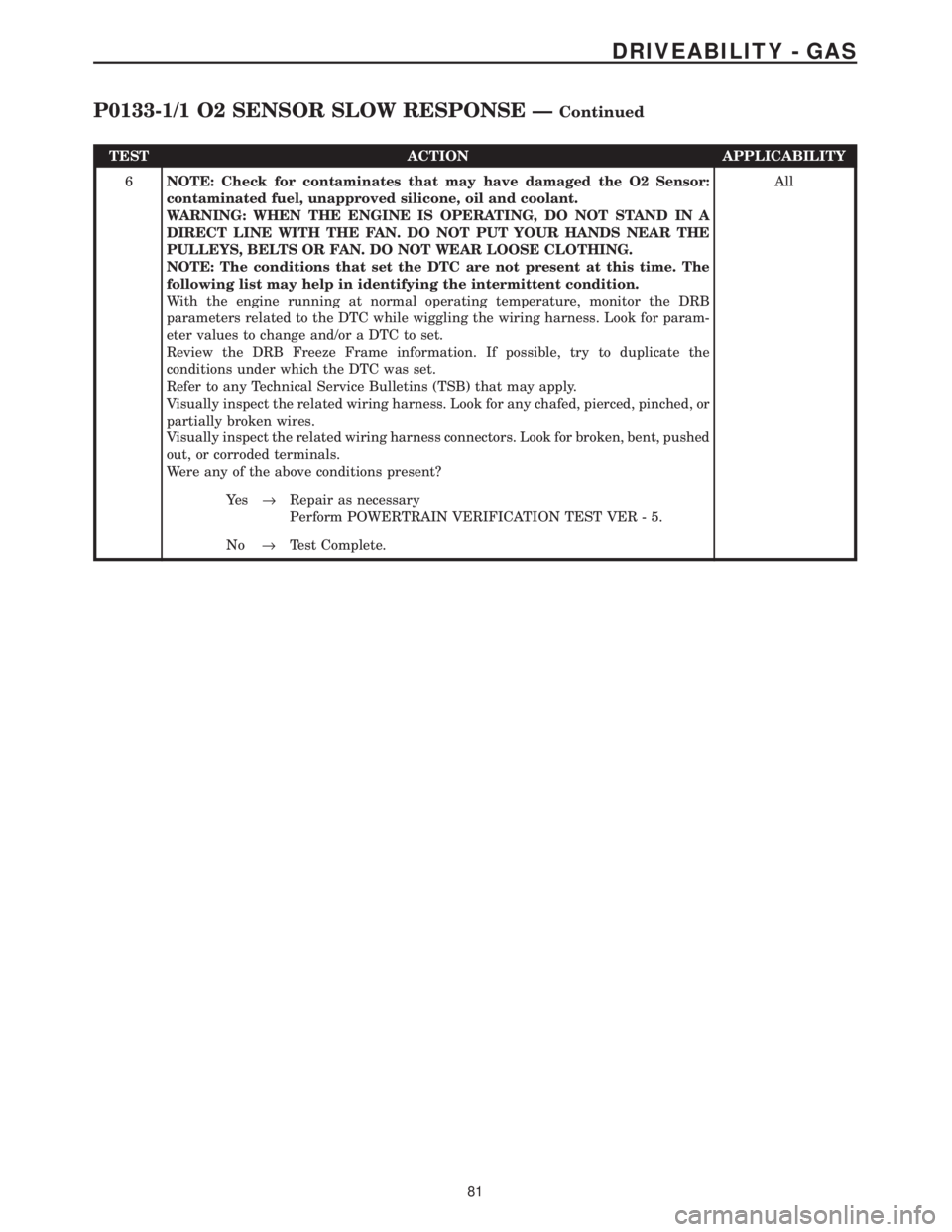
TEST ACTION APPLICABILITY
6NOTE: Check for contaminates that may have damaged the O2 Sensor:
contaminated fuel, unapproved silicone, oil and coolant.
WARNING: WHEN THE ENGINE IS OPERATING, DO NOT STAND IN A
DIRECT LINE WITH THE FAN. DO NOT PUT YOUR HANDS NEAR THE
PULLEYS, BELTS OR FAN. DO NOT WEAR LOOSE CLOTHING.
NOTE: The conditions that set the DTC are not present at this time. The
following list may help in identifying the intermittent condition.
With the engine running at normal operating temperature, monitor the DRB
parameters related to the DTC while wiggling the wiring harness. Look for param-
eter values to change and/or a DTC to set.
Review the DRB Freeze Frame information. If possible, try to duplicate the
conditions under which the DTC was set.
Refer to any Technical Service Bulletins (TSB) that may apply.
Visually inspect the related wiring harness. Look for any chafed, pierced, pinched, or
partially broken wires.
Visually inspect the related wiring harness connectors. Look for broken, bent, pushed
out, or corroded terminals.
Were any of the above conditions present?All
Ye s®Repair as necessary
Perform POWERTRAIN VERIFICATION TEST VER - 5.
No®Test Complete.
81
DRIVEABILITY - GAS
P0133-1/1 O2 SENSOR SLOW RESPONSE ÐContinued
Page 4042 of 4284
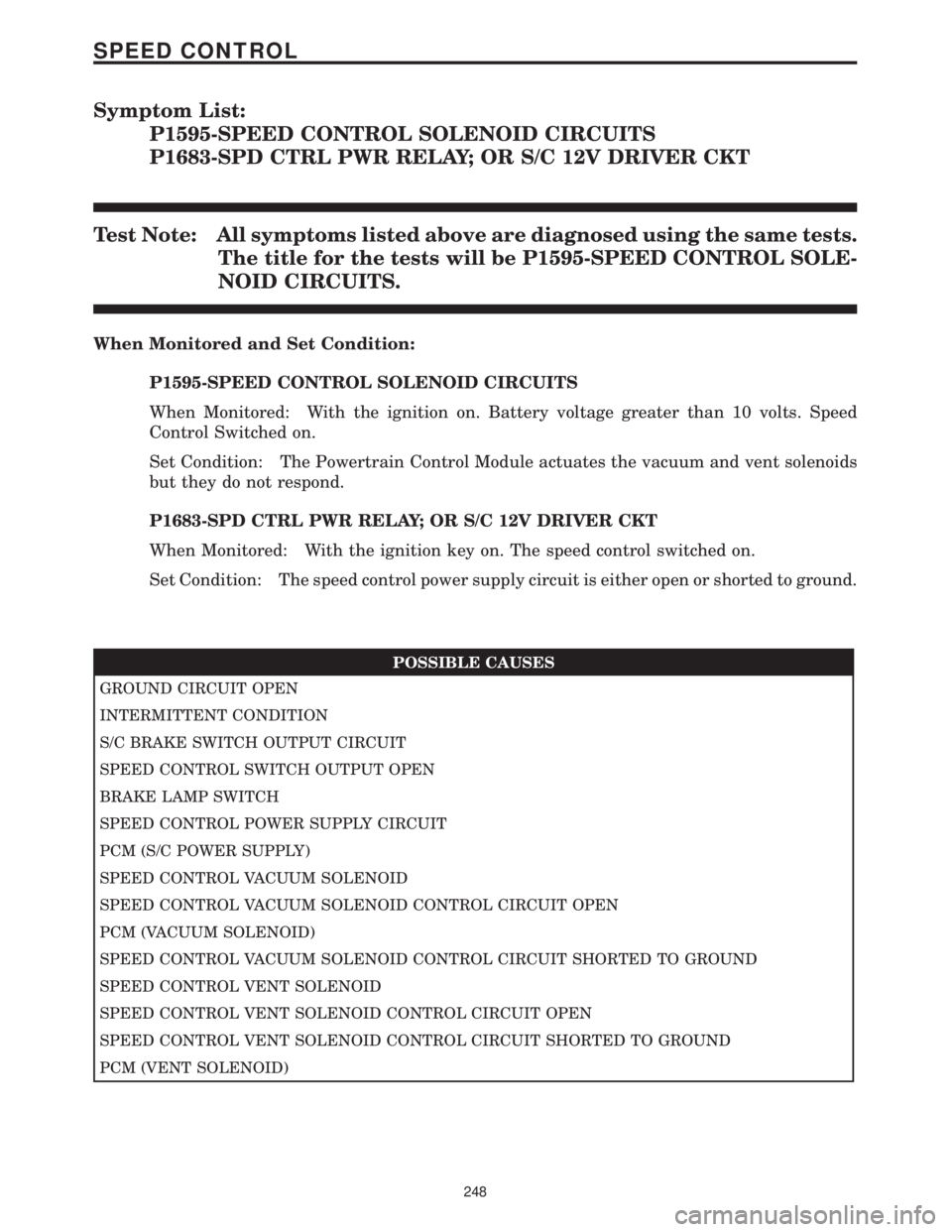
Symptom List:
P1595-SPEED CONTROL SOLENOID CIRCUITS
P1683-SPD CTRL PWR RELAY; OR S/C 12V DRIVER CKT
Test Note: All symptoms listed above are diagnosed using the same tests.
The title for the tests will be P1595-SPEED CONTROL SOLE-
NOID CIRCUITS.
When Monitored and Set Condition:
P1595-SPEED CONTROL SOLENOID CIRCUITS
When Monitored: With the ignition on. Battery voltage greater than 10 volts. Speed
Control Switched on.
Set Condition: The Powertrain Control Module actuates the vacuum and vent solenoids
but they do not respond.
P1683-SPD CTRL PWR RELAY; OR S/C 12V DRIVER CKT
When Monitored: With the ignition key on. The speed control switched on.
Set Condition: The speed control power supply circuit is either open or shorted to ground.
POSSIBLE CAUSES
GROUND CIRCUIT OPEN
INTERMITTENT CONDITION
S/C BRAKE SWITCH OUTPUT CIRCUIT
SPEED CONTROL SWITCH OUTPUT OPEN
BRAKE LAMP SWITCH
SPEED CONTROL POWER SUPPLY CIRCUIT
PCM (S/C POWER SUPPLY)
SPEED CONTROL VACUUM SOLENOID
SPEED CONTROL VACUUM SOLENOID CONTROL CIRCUIT OPEN
PCM (VACUUM SOLENOID)
SPEED CONTROL VACUUM SOLENOID CONTROL CIRCUIT SHORTED TO GROUND
SPEED CONTROL VENT SOLENOID
SPEED CONTROL VENT SOLENOID CONTROL CIRCUIT OPEN
SPEED CONTROL VENT SOLENOID CONTROL CIRCUIT SHORTED TO GROUND
PCM (VENT SOLENOID)
248
SPEED CONTROL
Page 4047 of 4284
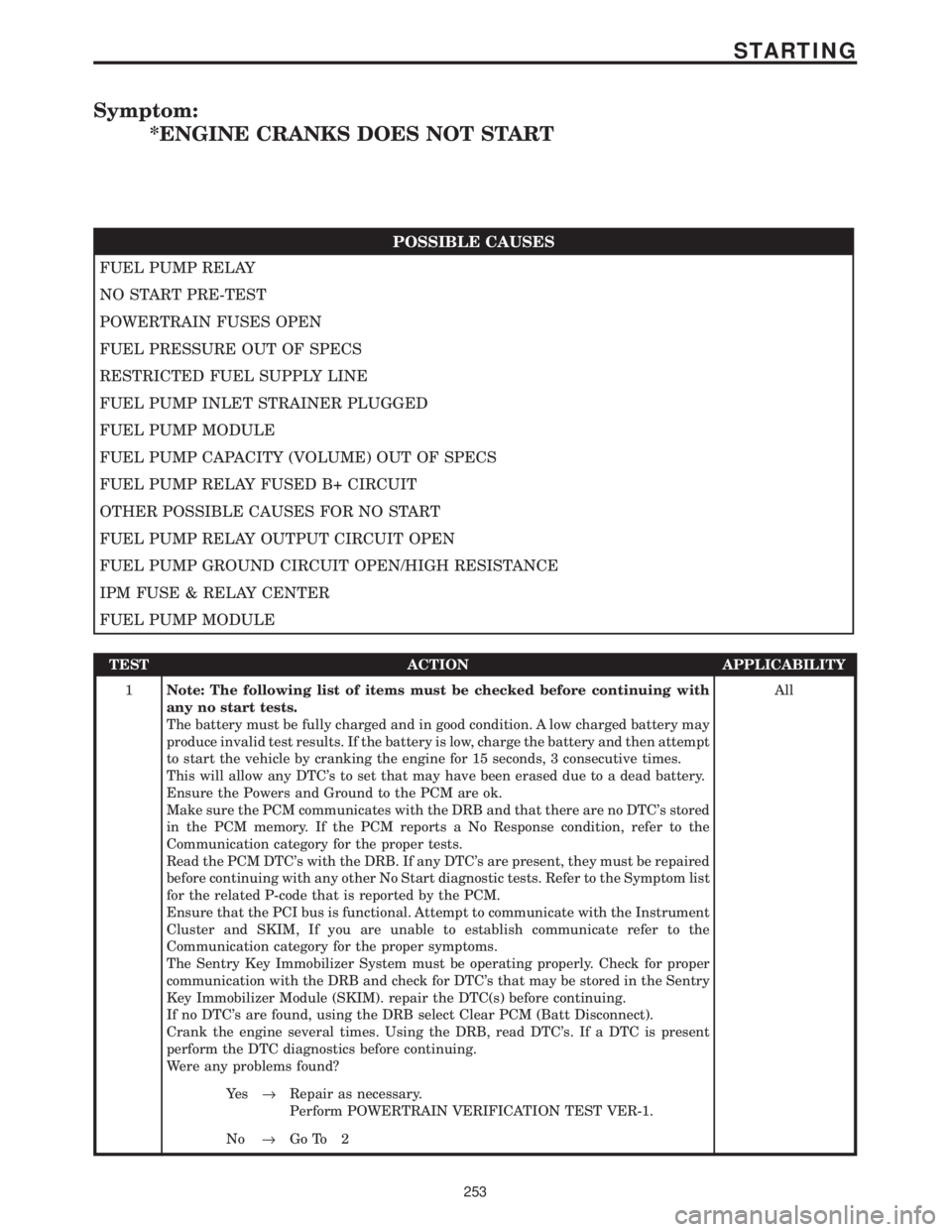
Symptom:
*ENGINE CRANKS DOES NOT START
POSSIBLE CAUSES
FUEL PUMP RELAY
NO START PRE-TEST
POWERTRAIN FUSES OPEN
FUEL PRESSURE OUT OF SPECS
RESTRICTED FUEL SUPPLY LINE
FUEL PUMP INLET STRAINER PLUGGED
FUEL PUMP MODULE
FUEL PUMP CAPACITY (VOLUME) OUT OF SPECS
FUEL PUMP RELAY FUSED B+ CIRCUIT
OTHER POSSIBLE CAUSES FOR NO START
FUEL PUMP RELAY OUTPUT CIRCUIT OPEN
FUEL PUMP GROUND CIRCUIT OPEN/HIGH RESISTANCE
IPM FUSE & RELAY CENTER
FUEL PUMP MODULE
TEST ACTION APPLICABILITY
1Note: The following list of items must be checked before continuing with
any no start tests.
The battery must be fully charged and in good condition. A low charged battery may
produce invalid test results. If the battery is low, charge the battery and then attempt
to start the vehicle by cranking the engine for 15 seconds, 3 consecutive times.
This will allow any DTC's to set that may have been erased due to a dead battery.
Ensure the Powers and Ground to the PCM are ok.
Make sure the PCM communicates with the DRB and that there are no DTC's stored
in the PCM memory. If the PCM reports a No Response condition, refer to the
Communication category for the proper tests.
Read the PCM DTC's with the DRB. If any DTC's are present, they must be repaired
before continuing with any other No Start diagnostic tests. Refer to the Symptom list
for the related P-code that is reported by the PCM.
Ensure that the PCI bus is functional. Attempt to communicate with the Instrument
Cluster and SKIM, If you are unable to establish communicate refer to the
Communication category for the proper symptoms.
The Sentry Key Immobilizer System must be operating properly. Check for proper
communication with the DRB and check for DTC's that may be stored in the Sentry
Key Immobilizer Module (SKIM). repair the DTC(s) before continuing.
If no DTC's are found, using the DRB select Clear PCM (Batt Disconnect).
Crank the engine several times. Using the DRB, read DTC's. If a DTC is present
perform the DTC diagnostics before continuing.
Were any problems found?All
Ye s®Repair as necessary.
Perform POWERTRAIN VERIFICATION TEST VER-1.
No®Go To 2
253
STARTING